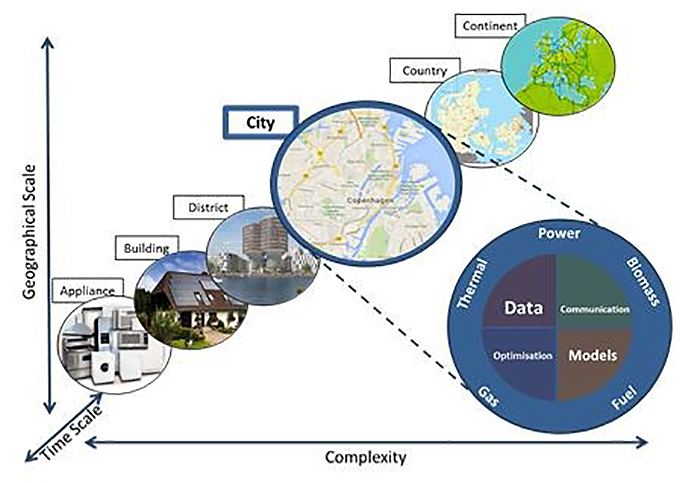Through seven years of research, five DTU institutes have been involved in developing and showing how data and AI make energy systems talk to each other. It saves money and helps make the world fossil-free.
Municipalities across the country are currently expanding the district heating network. This is good for the climate because district heating can contribute at least a third of the CO2 reduction of 70% - which is Denmark's climate goal. The research in the CITIES project (Center for IT-Intelligent Energy Systems - with headquarter at DTU and supported by the Innovation Fund Denmark) has created data-driven solutions to make district heating even more efficient.
- We estimate that the digital solutions developed in CITIES can provide savings of over one billion DKK per year alone in Denmark, says Henrik Madsen, Project Manager and Professor at DTU Compute.
In a report, CITIES, together with Damvad Analytics and the think tank Green Energy at the CITIES partner Dansk Fjernvarme, has shown that the district heating sector can save between 240 and 790 million DKK by introducing data-driven temperature control of the flow temperature because the temperature in the pipes can be lowered 3-10 degrees. Lower temperature results in lower heat loss, savings in energy production and reduce the CO2 emission. The analysis methods have since been further improved so the savings are estimated at DKK 200 million DKK extra.
"We estimate that the digital solutions developed in CITIES can provide savings of over one billion DKK per year alone in Denmark"
Henrik Madsen
This is just one of many results from CITIES 'research. The 43 partners, including five institutes at DTU; DTU Compute, DTU Elektro, DTU Energy, DTU Management and DTU Byg as well as AAU Planning, industry, utilities and Energinet have also developed software programs, mathematical models and AI that ensure that digitalization speaks directly into the green transition.
For example, through digitalization and coupling between energy systems, CITIES has developed solutions for energy storage without use of rare minerals such as cobalt and lithium. By intelligent control, supermarkets' cooling systems, treatment plants, district heating etc. can help the electricity market. Today, wind turbines are stopped if production exceeds demand.
- Based on price signals, the automatic model will be able to temporarily turn up cooling, heating and industrial processes so that they act as virtual batteries, and turn down when the electricity market can use the electricity and cut down even more during peak loads – and thereby utilize flexibility, explains Henrik Madsen.

The figure shows how we should be able to zoom in and out in planning and operation of the energy system on the household, the building, the city, the nation and the continent. CITIES has i.a. developed the state-of-the-art method SE-OS (Smart-Energy Operation-System), which can be used at all levels to develop, test and implement solutions (data, models, forecasting, management and optimization) in the pursuit for flexibility and sectoral coupling of energy systems.
State-of-the-art methods
During the project, CITIES has developed several state-of-the-art methods (models, forecasting, management and optimization) implemented through cloud, fog and edge computing, as well as IoT and service-oriented solutions for users. In addition, a spinoff company has just seen the light of day, while two other spinoffs with former CITIES' PhD students from DTU are in the making.
In addition to data-intelligent solutions, CITIES has pointed out that it is becoming increasingly difficult for citizens to become co-owners of wind farms. This is despite the fact that local co-ownership could facilitate the establishment of wind farms, which today are often met by citizen protests.
Finally, a CITIES' task force group has proposed that Denmark change the way the price of energy is put together to promote green conversion. If the price varies and is most expensive when the energy comes from fossil fuels, the price will motivate consumers to use electricity when it comes from renewable energy.
The research in CITIES has contributed to the establishment of two digital platforms for global infrastructure in the energy system. Center Denmark, which contains a 'data lake' for storage and processing of raw and anonymized energy data from thousands of households. The researchers and companies can use data for developing new business models and digital, green solutions. Uni-lab.dk, which brings together living labs to make it easy for the industry to test solutions. In addition, several new EU and fund-supported projects are based on research in CITIES.
CITIES’ research shows the following benefits – both economically and in relation to the reduction of greenhouse gases, if energy taxes and grid tariffs are designed so that prices vary and support the wish of being energy flexible:
- Up to one billion DKK in annual savings by temperature optimization in district heating
- Up to 90% savings by data-intelligent cooling of data centres, where the cold is created when the conditions are optimal, and stored in phase change material for use at times when, for example, the CO2 content in the stream is high
- 10-30% savings by being able to predict the heat demand from heat pumps
- 5-15% savings by integrating intelligent planning tools into home heat control
- 10-40% savings on electricity and heat consumption by using forecast tools that retrieve local weather forecasts from various weather services
- Up to 30% savings in greenhouse gases by smart control of both electricity consumption and processes in the wastewater management itself (minimization of nitrous oxide emissions)
CITIES has worked with digitalization and IT intelligence in relation to five main themes: Planning and operation of energy systems – including sectoral coupling of energy sources, Market mechanisms, Smart buildings that interact with the surrounding energy system, and CITIES taskforce has proposed changes to framework conditions (tariffs and energy taxes) so they encourage green transition.
Find research results, recommendations and software tools on CITIES website: https://smart-cities-centre.org/
From 2021, CITIES will continue as a centre for anchoring and disseminating solutions for smart energy systems in collaboration with Center Denmark and Energy Cluster Denmark.